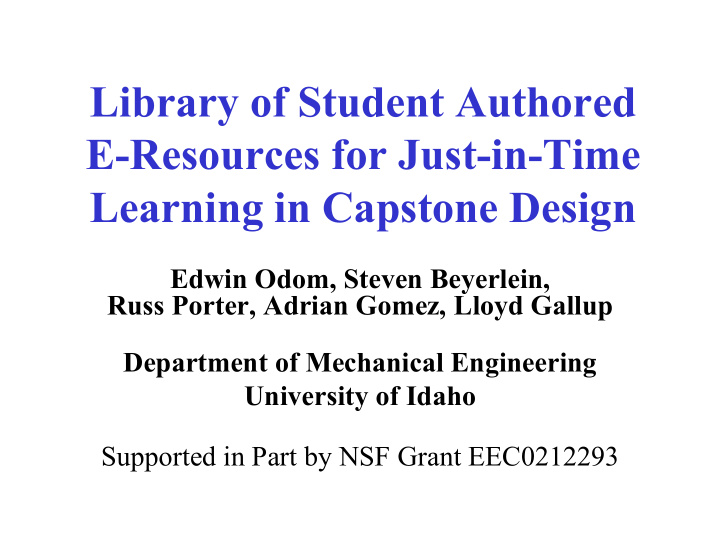



Library of Student Authored E-Resources for Just-in-Time Learning in Capstone Design Edwin Odom, Steven Beyerlein, Russ Porter, Adrian Gomez, Lloyd Gallup Department of Mechanical Engineering University of Idaho Supported in Part by NSF Grant EEC0212293
Today’s Outline 1. JIT Learning in Capstone Design 2. JIT Learning Infrastructure 3. E-Resource Philosophy 4. E-Resource Development Process 5. Existing E-Resources 6. Impact on SME Competencies
Capstone Design Experience year-long university/industry collaboration surrounding open-ended, real-world projects
Challenges in Product Realization Early Prototyping, Drawing Package Formation, Vendor Selection, Design for Manufacturing, Fabrication, Assembly, Testing
Knowledge Management Issues in Capstone Design • Annual turnover of personnel • Increasing student numbers • Escalating project complexity • Diverse project requirements • Declining hands-on experience • Evolution of hardware/software tools • Limited span of control by instructors
Step 1: Idaho Engineering Works Stewards of Design & Manufacturing Infrastructure • Graduate Student Mentors • Design Faculty Members • Professional Staff • Alumni in Regional Industry
Step 2: Lean Manufacturing Elective hands-on, 3-week, summer short-course • Become familiar with lean concepts and see sources of waste in a small shop setting • Learn standardized work procedures for common mill and lathe operations • Contribute to a visual workplace through point kaizen project
Step 3: Mindworks Laboratory www.webs1.uidaho.edu/ele/mindworks • Hardware Artifacts • Vendor Catalogs & CDs • Machine Design Templates • Student-Authored E-Resources • Self-Directed Project Learning
E-Resource Philosophy adapted from Greenfield Coalition • Faculty and professional staff need to play a central role in creating the learning environment. • Whenever possible, real-world linkages and local context should be used to enhance learning. • Learning is most compelling and enduring when students and faculty share responsibility for outcomes. • Learning is social, requiring group processing of new ideas for comprehension and application.
E-Resource Development Process Needs Analysis Specify behavioral outcomes mentors, faculty, and staff Recognize local context student authors Design Specifications Propose objectives student authors Approve objectives mentors, faculty, and staff Develop Skills and Scripts Deliver training students, mentors, faculty, and staff Create quick references and storyboard student authors Provide formative assessment mentors, faculty, and staff
E-Resource Development Process Resource Production Film and edit video student authors Maintain E-resource library mentors/faculty/staff Just-in-Time Use Identify situations/prompts for use mentors/faculty/staff Prepare for design/manufacturing activities student users Debrief student users mentors/faculty/staff Continuous Improvement Survey about strengths & improvements student users Establish priorities for revision mentors/faculty/staff
Current E-Resource Catalog E-videos, E-posters, E-templates, E-tutorials Shop Safety Measurement Devices (4) Shop Orientation Heat Treatment Shop Tool Inventory (15) Anodizing Drilling & Tapping Welding (3) Feeds & Speeds Rapid Prototype Machine Finishing a Part Drawing Package Formation (3) Tramming a Mill Machine Design (15) CNC Lathe Advanced CAD Tutorials (5) CNC Mill Capstone Assessment Tools (5)
Step Drills Purpose: The step drill is used to drill a hole in thin metal, such as sheet metal. A normal drill will try to lift sheet metal off of the table and spin it. • Secure/Clamp work piece. Safety : • Debur edge to prevent cuts. Steps for Use: 1. Determine diameter of hole desired. 2. Insert appropriate step drill into drill press. 3. Determine depth required to achieve the diameter. 4. Drill to desired depth to achieve diameter. 5. Clean up Figure 1. Step drill location cabinet 2 Available Step Drill Sizes Min ∅ Max ∅ ∅ Step size Depth between step 1/8 1/2 1/32 1/8 1/4 3/4 1/16 1/8 1/4 7/8 ~*~ 1/16 3/16 1/2 1/16 3/8 Figure 2. Typical Step Drills 3/4 1 1/2 1/16 1/8 Vendor : http://www.MSC.direct.com Table 1. Available step drill sizes.
Impact of E-Resources on Manufacturing Competencies Rubric for Skill Development 0 – unfamiliar with skill 1 – able to explain importance of skill to others 2 – able to perform skill with extensive coaching 3 – able to perform skill with minimal coaching and independently learn more as needed 4 – able to solve problems and teach others
Impact of E-Resources on Manufacturing Competencies Skill Area Authors (30) Mentors (8) Shop Safety 2 3.5 4 Shop Cleaning 2 3.5 4 0 3 Tool Storage 4 Mill Operations 1 2.5 3.5 Lathe Operations 1 2.5 3.5 CNC Coding 0 2 3 Part Drawings 2 3 3.5 1 2.5 Tolerancing 3.5
Recommend
More recommend